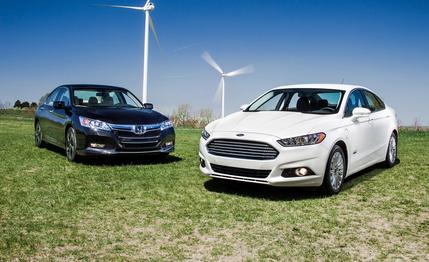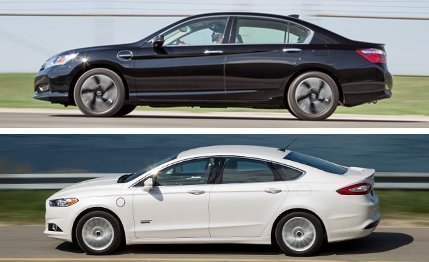
 Comparison Tests
Comparison Tests
If you are dubious about electrified cars entering the American fleet, consider the two subjects of this comparison test. Both of these models were newly redesigned for 2013, and, as of this writing, the Honda Accord is the bestselling nameplate in the country. The Ford Fusion is the third-best seller. But their respective companies are not putting their feet up on their desks. Both are introducing plug-in hybrid versions of their crowd-pleasers—the first such powertrains to be added to cars normally equipped with conventional engines.
The Ford Fusion Energi was quicker out of the gate, hitting the market a few months after the Fusion hybrid. Both cars, as well as Ford’s C-Max twins, share the same powertrain: a 141-hp, 2.0-liter four-cylinder Atkinson-cycle internal-combustion engine coupled to a pair of AC electric motors. A 118-hp motor propels the car while a second motor-generator works with a planetary-gear continuously variable transmission (CVT) to blend the internal-combustion and electric power as needed.
The biggest difference between the Fusion Energi and the Fusion hybrid is the size of their lithium-ion battery packs. It grows in the Energi about five-fold, from 1.4 kWh to 7.6. That’s enough to provide the Energi with an electric-only range of 21 miles, according to the Environmental Protection Agency, while achieving 100 MPGe (or miles per gallon of gasoline equivalent, the EPA’s convoluted method of placing an mpg rating on electric vehicles). Thanks, however, to the nearly 300-pound weight increase that accompanies the bigger battery, the fuel consumption when operating on gasoline falls from the hybrid’s 47-mpg EPA rating to 43.


Honda didn’t invent a fancy name for its new model, calling it simply the Accord Plug-In, though the badges on the car say “hybrid.” We’ll see what the company does when the non-plug-in Accord hybrid arrives in the fall. In any case, this Honda uses a new hybrid system unlike any we've seen before. The 2.0-liter Atkinson-cycle four-cylinder develops the same 141 horsepower as the Fusion's engine. Honda uses two electric motors, like the Fusion; but here one drives the wheels, the other serves mainly as a generator. The Accord’s traction motor develops 166 horsepower—48 more than the Ford’s, though the combined output is up only eight horsepower on the Fusion to an estimated 196. While the Accord Plug-In hybrid is the first application of Honda’s new two-motor system, it will also appear in an Accord hybrid equipped with a smaller-capacity lithium-ion battery.
Honda has fitted a slightly smaller battery than has Ford, rated at 6.7 kWh, and this produces roughly a third less rated electric range—only 13 miles. But just as the conventional Accord is about 200 pounds lighter than the equivalent Fusion, so is the PHEV version. That results in 115-MPGe and 46-mpg EPA-combined ratings, both of which beat the Fusion’s numbers.
Technology costs money, so the base price of each car lands around $40,000, or about 10 grand dearer than similarly equipped, conventionally powered equivalents. This lofty pricing puts these two plug-ins up against the Chevy Volt. Yes, the Volt is smaller than these mid-size sedans, but you’re only going to notice that from the rear seat. On the other hand, the Volt has more trunk space than either the Fusion or the Accord and greater electric range. In contrast to the Ford and Honda plug-ins, the Volt is electrically driven all of the time. And thanks to a federal tax credit that’s keyed to battery capacity, the Volt can actually be less expensive. When you drive either of the cars in this test, though, you won’t be behind the wheel of so obvious a political punching bag.